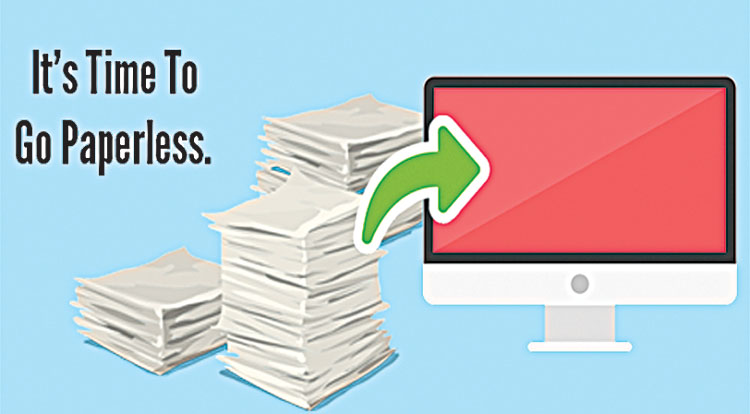Not only does going paperless save time, it’s economical too. Reducing paper means less money spent on buying paper, printing, or toner, as well as costs related to storage of paper documents.
A paperless office, also called a paper-free office, is a work environment which uses minimal physical paper and instead uses primarily digital documents. A paperless employee is a worker who has eliminated or greatly reduced the use of paper in the workplace. The process of converting paper files into electronic files is known as digitization. The idea of an entirely paperless office has existed since personal computers became the basis of the modern workplace. Despite the prevalence of electronic documents and email, most organizations still rely on paper documents. There are many benefits to going paperless, from saving resources to boosting security. Yet from handouts at meetings and HR onboarding documents to receipts, many business processes still revolve around paper.
Benefits:
Saves Time: Time spent filing, organizing, and searching for paper documents is time that could be spent on more productive tasks. Digitized documents are stored in a central repository, which is basically a well-organized digital filing cabinet where all of your documents live. Using a digital document management system, you’ll get to harness the same powerful search abilities that you’re used to using on Google. This means employees can find files at the click of a button, much more quickly than the laborious, manual process of searching for a specific file in a buried folder. Employees are able to use this extra time on revenue-generating projects.
Saves Space: Paper takes up a lot of space – as do filing cabinets and space to store those filing cabinets. Books and bookshelves are bulky, too. What’s worse, paper keeps piling up, oftentimes accumulating more quickly than it can be sorted and organized. This is particularly true of industries that have long mandatory retention periods for paperwork like the financial industry. Digitizing files allows you to store all documents either on an on-premises server or in the cloud. Digital file folders in a repository require much less space than a physical records archive.
Saves Money: Going digital improves process efficiency, saving you money. Paperless offices can process a much larger volume of paperwork compared to traditional offices in the same amount of time. Further, digitization reduces money spent on paper, printers, ink, postage, office space for files and employee time to manage paperwork. The savings on employee time become especially valuable in regards to regulatory audits and repetitive, high-volume tasks like expense reimbursements.
Eases Transfer of Information: Document management software offers a simple process for saving documents. The software easily compiles digital documents using scanners, mobile capture using a camera on a phone or tablet or importing any file type (.docx, .pdf, image files). Many commonly used applications, like Microsoft Office and Adobe Acrobat, integrate with document management systems and have native plugins which allow you to file your document into your content management system with just one click.
Promotes the Environment: Manufacturing paper products produce greenhouse gases, causing deforestation and global warming. Recycling can offset some of the environmental impact, but not by much. Most paper eventually ends up in a landfill. Further, ink and toners contain volatile compounds and non-renewable substances which are damaging to the environment. It is much more sustainable to simply reduce paper use altogether by switching to a paperless office.
Boosts Security: Physical documents are hard to track – reams of paper can get lost, misfiled or destroyed without anyone noticing. It can also be difficult to monitor the access, printing and copying of sensitive files. Document management software has advanced security capabilities that can tackle these challenges. System administrators can set-up granular access rights, which assign permissions at the document level (e.g. settings based on the type of document), user level (e.g. settings based on person’s job function), or system level (e.g. overarching security for all data in the system).
The security benefits of a paperless workplace go beyond access rights. Implementing document management software also allows organizations to leverage electronic signatures, redact confidential information, create audit trails and more.
Digitizing Paper-Based Processes: Technology has so seamlessly replaced paper processes that it’s difficult to remember how things used to be done. In nearly all cases, the evolution from paper-based items to their electronic counterparts is profoundly more efficient.

